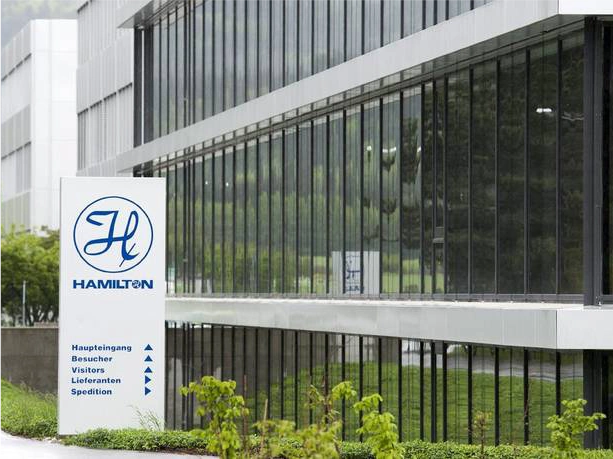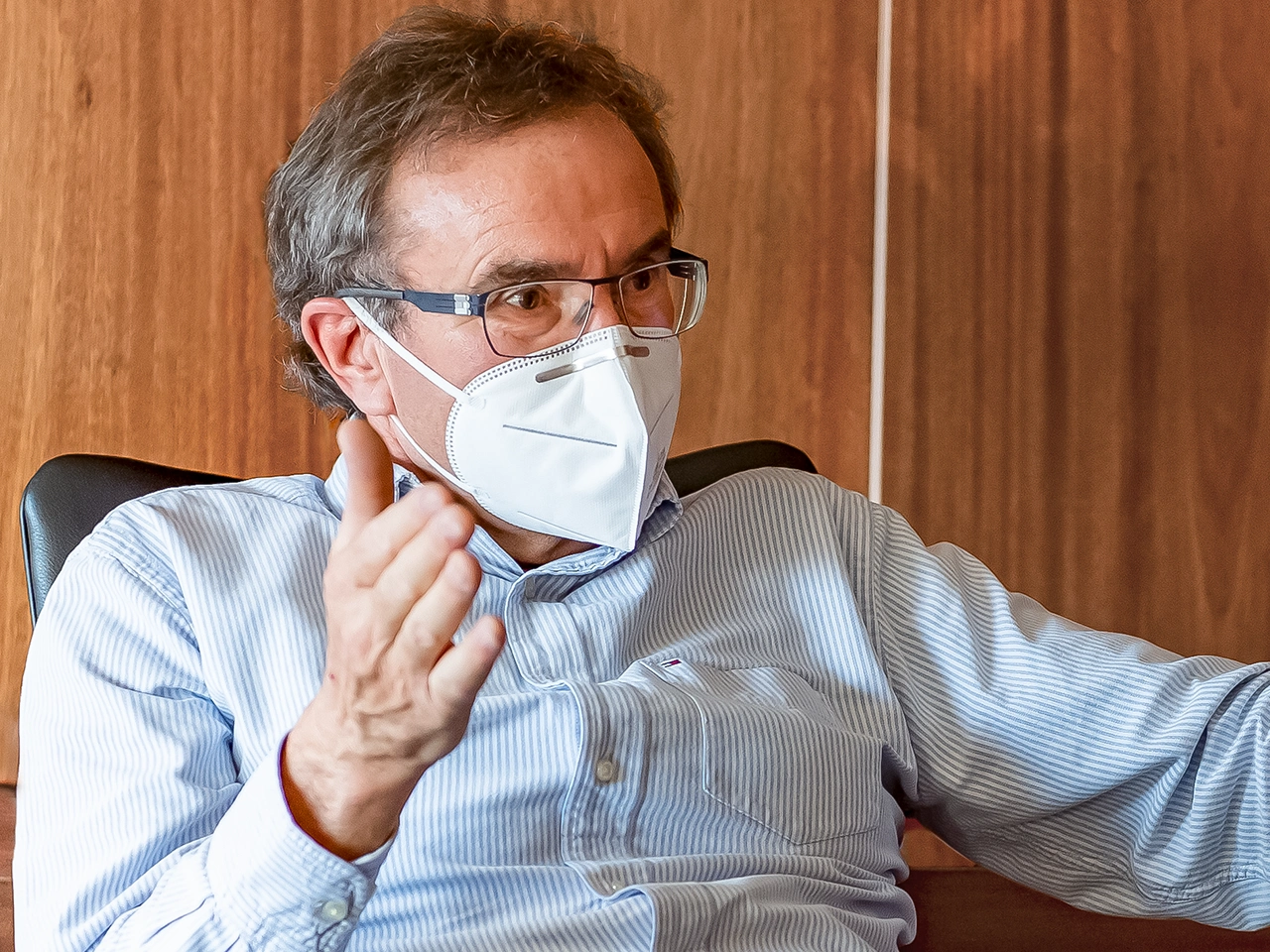Home > Company > Publications > Andreas Wieland
The fragility of global supply chains: how to maintain supplies in a crisis
The coronavirus pandemic has been a dramatic reminder of how fragile global supply chains are. Lockdowns in countries around the globe stopped production facilities and blocked transport routes, and in particular the reduced intercontinental air and sea transport capacities caught many industrial companies completely off guard. One exception was the technology company Hamilton Bonaduz AG in the Graubünden Rhine Valley.
Global demand for ventilators, laboratory robots and other life science solutions from Hamilton has dramatically increased during the pandemic. How did the company manage keep up with this demand? CEO Andreas Wieland talks to Daniel Bachofen.
Daniel Bachofen: At the start of 2020 we discovered that the virus was not confined to China and had already reached Western Europe. What were your first thoughts at the time?
Andreas Wieland: We weren’t surprised by the global spread of Covid-19. Even before Christmas 2019, I knew from talking to Chinese business partners in virology and blood bank management that something big was looming. I knew from experience that there would be problems procuring parts from Asia.
DB: What did you do?
AW: Right at the beginning of the year I told my people to purchase as much material as possible. We bought what we would need for the next six months practically all at once. This gave us a big advantage over the competition. Many competitors didn’t grasp the gravity of the situation until it was almost too late.Remember that we’re not newcomers to the business. We could look back on our experience from previous pandemics such as SARS-CoV-1 and were aware of the risks that they bring. And that includes risks to supply.
DB: In general, did industrial companies in the West underestimate the vulnerability of global supply chains and their dependence on supplies from Asian markets such as China, or did they deliberately take the risk of interruptions to the production of parts or blockages and restrictions of transport routes?
AW: You should always learn from experience. I remember the eruption of the volcano in Iceland in 2010, which almost paralysed international air traffic. Maybe some companies didn’t give it much thought at the time. People tend to shop where prices are cheap and the necessary delivery capacities are available. They often ignore the risks. Many companies are now painfully finding out what consequences this can have.
DB: Talking about risk – pandemics are one thing, cybersecurity is another. How big is the risk of supply chains being impaired or even interrupted by hacker attacks?
AW: It’s a real danger and a very big one too. We go to great lengths to ensure IT security. It doesn’t even have to be hackers; the pandemic has also shown that it’s hard to overestimate the importance of cybersecurity. For example, when IT systems and networks are disrupted, you might not know where your transport containers are, and large shipping companies may no longer operate properly. We have become very vulnerable.
DB: What specific experiences have you had of this in the current crisis?
AW: At the start of the pandemic we had no problems because we had prepared early. Later on, we discovered that supplies from China were getting held up because air routes were interrupted, the railways were overloaded and lorries were held up at national borders. What made the situation worse for us was that our suppliers were suddenly prohibited from exporting some of the medical products that we purchase. That gave us a bit of a headache.
DB: Were the regulatory obstacles put in your way roughly the same everywhere?
AW: It was very different. For example, we buy large quantities of circuit boards and other electronic products from Sri Lanka, where there was a state-ordered halt to production, in other words a lockdown. This acutely jeopardised the manufacture of ventilators. Because these are essential goods, Mr Cassis of the Swiss Federal Council personally appealed to the Sri Lankan government on our behalf. The ban was lifted. We enjoyed the same support with the same result for supplies from India.
DB: Integrated circuits are another important product where there are global supply bottlenecks. Are you affected by this?
AW: Again, we acted early, back in autumn 2020. I was convinced that the automotive industry’s demand for semiconductors would increase massively after the pandemic. That’s why we bought as much electronics as we could, even at the risk of having a surplus. This sort of thing takes a lot of entrepreneurial courage. But the biggest risk is not doing anything and then running into supply shortages. If we end up with too much material in stock, we’ll use it six months later anyway.
DB: What other measures did you take to protect yourself from shortages?
AW: We’ll certainly go back to sourcing more supplies from our own region, in other words Europe. Incidentally, some of our partners took advantage of the situation and put up their prices. We’ve stopped working with them.
DB: Do you see a trend in Switzerland towards local procurement and production?
AW: That’s the way it’s going, at least as far as we’re concerned. For example, we will be producing plastic parts that we used to have manufactured in Italy at our second site in Domat/Ems. Consumables that we have to deliver at short notice at any time are also an issue. This is why we have expanded production in Switzerland and are going to do the same near our plant in the USA.
DB: Doesn’t local production mean higher costs?
AW: Quite the opposite – some of the costs are much lower now. We’re fully committed to automation. To do this, we have highly qualified engineers and an excellent infrastructure in Switzerland. Also, money is cheap to borrow at the moment, which is another incentive to invest.
DB: The global spread of Covid-19 has hugely increased the need for ventilators. Your were overwhelmed with inquiries and orders. According to the laws of the market, you could have massively increased your prices.
AW: We haven’t put a penny on our prices. We deliver our medical equipment to where it is most badly needed. Our criteria include infection and illness rates and the state of the health system. Some governments and embassies intervened and in some cases put pressure on us. But we were always able to counter their demands with the argument that we must prioritise help where it is most needed.
DB: On 30 December 2020, the NZZ reported that the number of ventilators manufactured worldwide has quintupled in the past year and will collapse by a factor of ten to between 30,000 and 40,000 in 2021. It would take three to five years to reduce the oversupply. Would you agree with that?
AW: You have to differentiate. Most of all, the pandemic has boosted demand for low-cost devices, so that’s what everyone manufactured. So did we – but not only. Hospitals with high standards require high-quality machines. We responded to this need early on and started producing high-end devices as early as April 2020. This has hugely expanded our customer base, which means it’s still an interesting market. Incidentally, in December 2020 and the first month of this year we achieved roughly the same turnover with ventilators as we did between December 2019 and mid-April 2020.
DB: Are your devices manufactured for Covid-19 treatments based on traditional technical concepts or are they new developments?
AW: The pandemic provided a spark for our product development. As I said before, we recognised the situation at the beginning of 2020 and were the first to supply the market with low-cost devices. Then we decided that test equipment was needed, and in a very short time we launched two new, automated, assay-ready pipetting machines for fast, high-throughput testing. Around 60 percent of all Covid-19 tests are carried out on Hamilton devices. As logic dictates, we dealt intensively with the topic of vaccination – again at an early stage – and now offer process sensors that are required for the production of vaccines. We also responded quickly to the appearance of mutations, which can be very efficiently identified and sequenced with our devices.
DB: Is remote access to your devices, for example in hospitals for monitoring and maintenance, an interesting topic or is it rather problematic with regard to the protection of sensitive health data?
AW: We’re already using machine learning, algorithms and big data analytics, for example for pattern recognition. The aim is to facilitate the best possible treatments for patients. We’re determined to be at the forefront of digitalisation. Already, every single Hamilton device is connected to the Internet. That gives us control over our data, which means we have a big advantage in hospitals over our competitors.
DB: To keep up with the huge demand for Hamilton devices, your company works 24/7 …
AW: We do have areas where our infrastructure is at full stretch. But that’s partly because during the pandemic we must minimise the number of employees working at the same time, and make sure they all keep their distance. The Graubünden authorities were very flexible, and quickly granted us authorisation to work on Sundays.
DB: So what’s next for Hamilton?
AW: We are primarily established in the healthcare sector. Ventilation will always be in demand, because unfortunately more and more people are having respiratory problems due to air pollution. Another very exciting field for us is DNA analysis, which is used for example in medical and pharmaceutical research, as well as in completely different areas such as police investigations. If we think beyond healthcare, food production could provide interesting applications for Hamilton technologies. People will always eat. We’re also active in the environmental sector, namely in water and air analysis as well as oxygen measurement – all topics with long-term prospects.
This conversation took place at the beginning of February 2021 at the headquarters of Hamilton Bonaduz AG.
The globally active Hamilton group is one of the leading suppliers of technology for life sciences, sample management and medical technology. At its Swiss locations in Bonaduz and Domat/Ems, Hamilton develops and produces ventilators, innovative robots for laboratory automation, sensors for the biopharmaceutical industry and other automation solutions for research and production. Important customers include hospitals and laboratories around the world. Hamilton also has a strong presence in the growing markets of genetics, robotics, food and the environment.
Hamilton employs 3,000 people worldwide, half of them in the Graubünden Rhine Valley. Another 15 locations are located in Zürich, Basel and Rapperswil in Switzerland, as well as in the USA, China, Romania and seven other countries in Europe. The Hamilton companies are owned by the Hamilton family from the United States.


